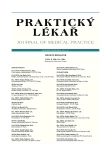-
Medical journals
- Career
Differential diagnosis of genital ulcerations
Authors: P. Procházka 1; V. Resl 2
Authors‘ workplace: Medicentrum Beroun spol. s r. o., Dermatovenerologická ambulance Praha 5 – Kartouzská, Vedoucí lékař: MUDr. Přemysl Procházka 1; Fakulta zdravotnických studií ZČU, Plzeň, Děkan: doc. MUDr. Luboš Holubec, CSc. 2
Published in: Prakt. Lék. 2012; 92(9): 499-504
Category: Various Specialization
Overview
In the framework of differential diagnostics concerning genital ulceration, it is necessary to think of the specific etiology in the first place – the primary stage of syphilis. Laboratory tests help to determine the diagnosis. Currently the number of recorded cases of fresh forms of syphilis is increasing. Further investigation needs be to carried out to exclude the presence of any other STI. The most frequent causes of ulceration on the exterior of the genitals are non-specific STI: HSV I+II viral infection, erosive balanoposthitis caused by yeast, or a mixture of anaerobic microbes. The manifestation of autoimmune diseases (pemphigus vulgaris or pemphigoid bullosus) or drug toxicoallergic reaction such as Stevens – Johnson syndrome are not uncommon. Histology tests need to be carried out in case of possible ulcerative presence of genital tumours. On rare occasions, genital ulceration belonging to systemic disorders (Behcet and Reiter syndromes), non-venereal treponematosis, or serotypes infection L1, L2, L3 of lymphogranuloma inguinal (venereum) can be found. The diagnosis of ulcer mole and rarely seen forms of syphilis such as chancre redux (II. stage reindurations of secondary infection) and pseudochancre redux (gumma syphiliticum at the of point of ulcer durum without spirochete) needs to be taken into consideration.
Key words:
genital ulcerations, differential diagnosis, syphylis, herpes progenitalis, ulcus molle, balanitis errosiva, lymphogranuloma venereum, tumours, STI, STD
Sources
1. Braun-Falco, O., Plewig, G., Wolff, H.H.: Dermatológia a venerológia. 1 vyd. Martin: Osvěta, 2003.
2. International Union against Sexually Transmitted Infections (IUSTI). Current European Guidelines [on-line]. Dostupné na www.iusti.org/regions/europe/euroguidelines.htm#Current.
3. Resl, V.: Diferenciální diagnostika syfilis. Referátový výběr dermatovenerologie, 2012, roč. 54, č. 2, s. 19–28.
4. Resl, V., Voltr, J., Pizinger, K.: Venerologie. Praha: UK Karolinum, 1993.
5. Resl, V.: Venerologie. Programy kvality a standardy léčebných postupů. Praha: Verlag Dashöfer, 2003.
6. Resl, V.: Diferenciální diagnostika kožních nemocí oproti syfilis (elektronická pošta) 2/2012
7. Centers for Disease Control and Prevention. 2010 STD Treatment Guidelines [on-line]. Dostupné na http://www.cdc.gov/std/treatment/2010/default.htm.
8. Štork, J. a kol.: Dermatovenerologie. Praha: Galén, 2008, s. 429–442.
9. Wald, A., Link, K.: Risk on human immunodeficiency virus infection in herpes simplex virus type 2 – seropositive persons. Infect. Dis., 2002, 185, p. 45–52.
Labels
General practitioner for children and adolescents General practitioner for adults
Article was published inGeneral Practitioner

2012 Issue 9-
All articles in this issue
-
Basics of social cognitive and affective neuroscience.
XXIII. Optimism - Primary prevention of congenital anomalies
- Acute bleeding from oesophageal varices
- Differential diagnosis of genital ulcerations
- Psychosocial care of women after perinatal death
- The needs of parents of children with cerebral palsy
- Psychological aspects of stress on medical students
- Paraneoplastic limbic encephalitis in a young male with a testicle tumour
-
Basics of social cognitive and affective neuroscience.
- General Practitioner
- Journal archive
- Current issue
- Online only
- About the journal
Most read in this issue- Differential diagnosis of genital ulcerations
- Acute bleeding from oesophageal varices
- Psychosocial care of women after perinatal death
- Psychological aspects of stress on medical students
Login#ADS_BOTTOM_SCRIPTS#Forgotten passwordEnter the email address that you registered with. We will send you instructions on how to set a new password.
- Career

